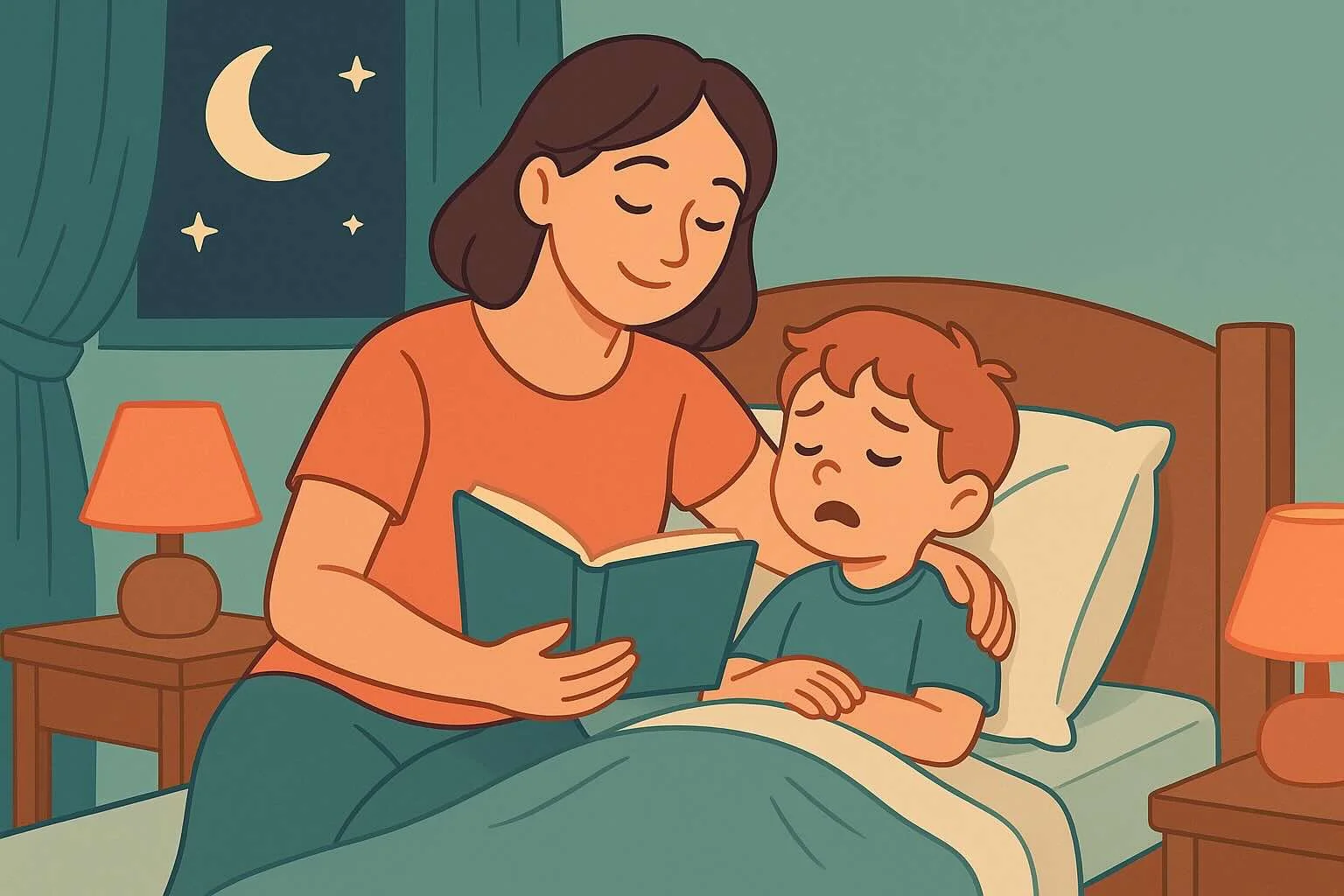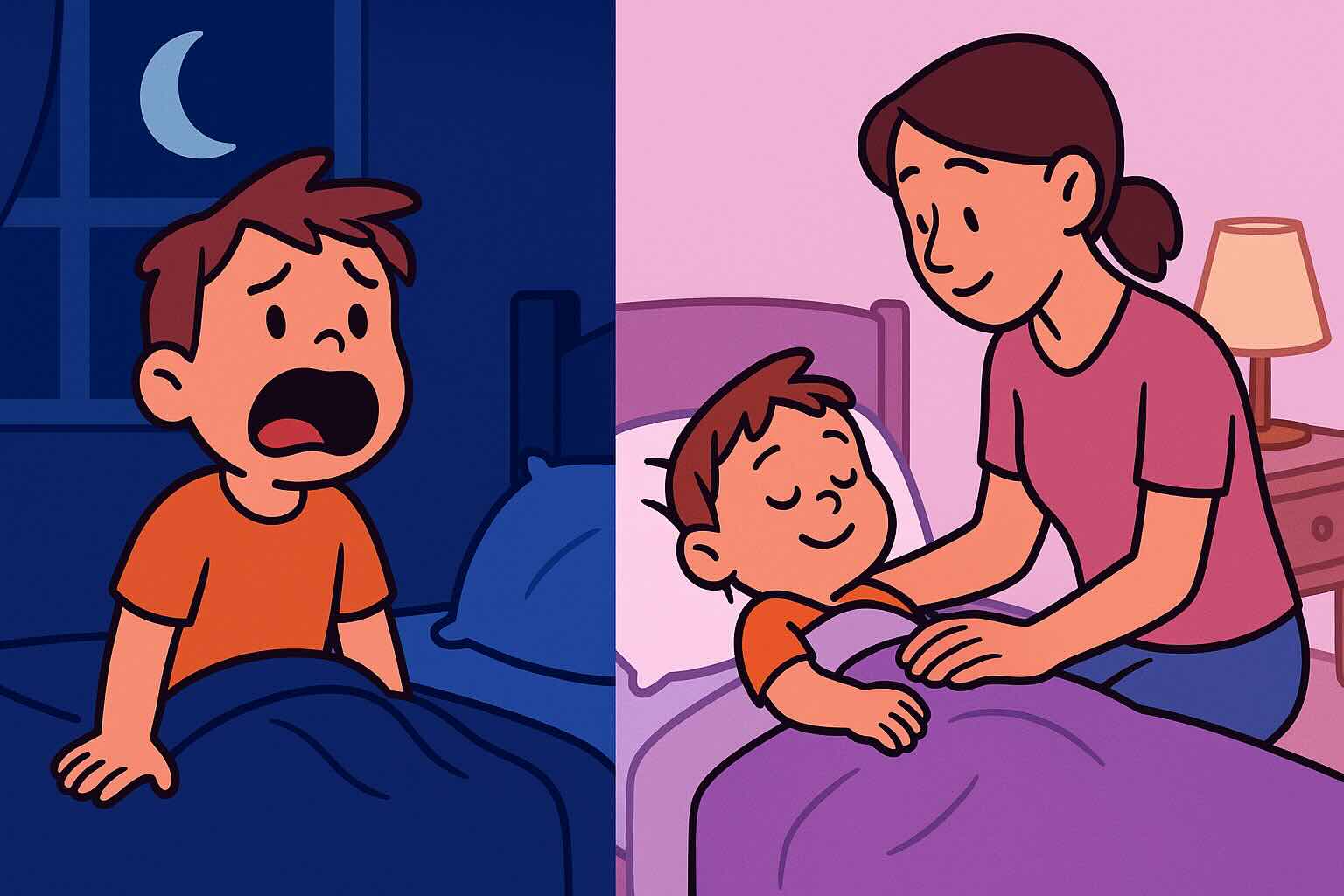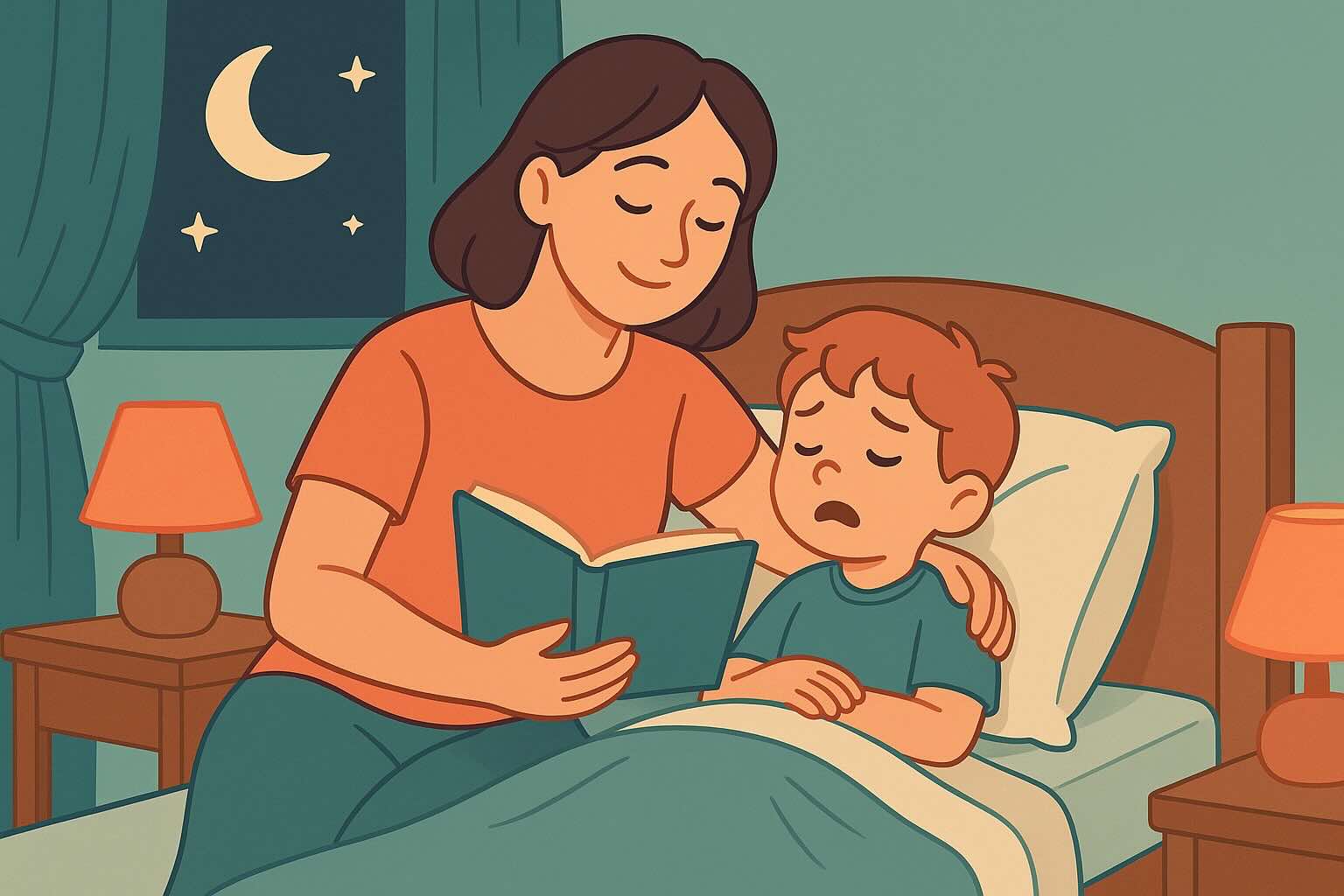Healthy Sleep Habits for Kids: 12 Science-Backed Strategies (Ages 3-7)

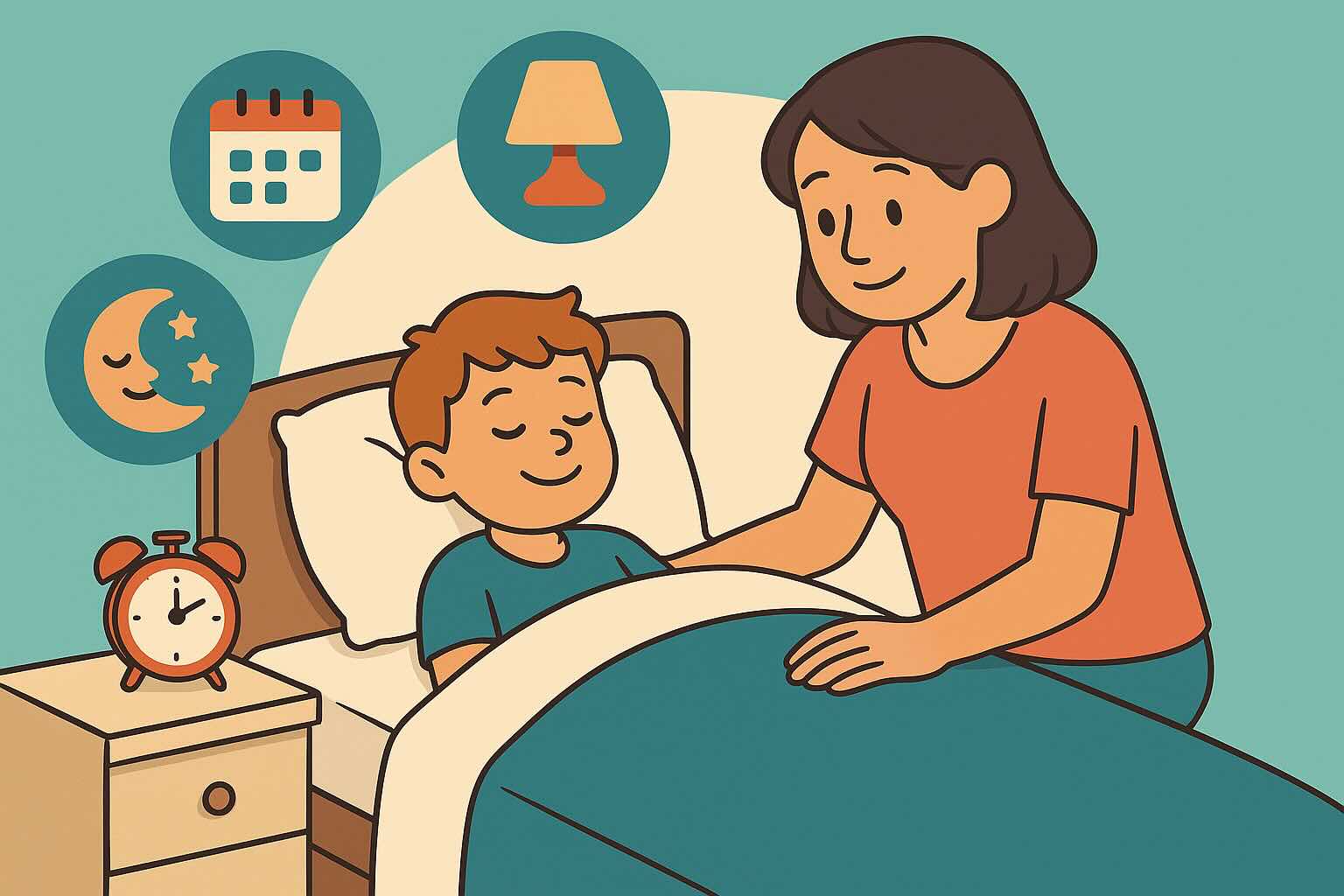
If you're tired of negotiating bedtime every night, dealing with cranky mornings, or watching your child struggle with attention and emotional regulation during the day, the solution might be simpler than you think. Research shows that children with consistent, healthy sleep habits score 23% higher on cognitive tests, have 40% fewer behavioral problems, and show significantly better emotional regulation compared to children with poor sleep hygiene.
This comprehensive guide provides evidence-based strategies for building lasting healthy sleep patterns that support your child's physical development, brain growth, learning capacity, and emotional wellbeing.
What You'll Learn in This Guide
- Sleep Needs by Age - Specific requirements for optimal development at each stage
- The Foundation Elements - Core habits that make everything else easier
- Daily Sleep Architecture - How to structure 24-hour sleep-wake cycles
- Environmental Optimization - Creating spaces that naturally promote quality sleep
- Routine Construction - Building bedtime and morning routines that work
- Lifestyle Integration - How diet, exercise, and daily activities affect sleep
- Troubleshooting Common Issues - Solutions for frequent healthy sleep challenges
- Long-Term Sustainability - Maintaining good habits through changes and challenges
For specific sleep challenges, also see our targeted guides on stopping bedtime battles, overcoming bedtime fears, solving night wakings, and transitioning to independent sleep. If you're considering structured sleep approaches, review our evidence-based sleep training guide. If your child experiences intense nighttime fears, our comprehensive nighttime fears guide provides additional strategies for creating peaceful bedtimes.
Estimated reading time: 15 minutes
Understanding Sleep Needs: The Science of Growing Bodies and Brains
Age-Specific Sleep Requirements
Ages 3-4: The Transition Period
- Total sleep needed: 10-13 hours per 24-hour period
- Typical pattern: 10-12 hours nighttime + 1-2 hour afternoon nap
- Individual variation: Some children drop naps early, others need them until age 5
- Key developmental factors: Rapid brain development, language explosion, emotional regulation building (see our understanding brain changes guide for parent adaptation insights)
Ages 5-6: The School Readiness Phase
- Total sleep needed: 10-12 hours of nighttime sleep
- Typical pattern: Single nighttime sleep period, occasional rest time
- Nap considerations: About 50% still benefit from quiet rest or brief naps during growth spurts
- Key developmental factors: Cognitive demands increase, social pressures emerge, physical activity needs rise
Ages 7+: The Independent Sleeper
- Total sleep needed: 9-11 hours of nighttime sleep
- Typical pattern: Consistent nighttime sleep without daytime naps
- Special considerations: Academic demands, extracurricular activities, social influences
- Key developmental factors: Abstract thinking develops, peer relationships matter more, independence grows
Why Sleep Quality Matters More Than Quantity
Deep sleep functions (crucial for ages 3-7):
- Physical growth: Growth hormone release occurs primarily during deep sleep
- Memory consolidation: Information learned during the day gets organized and stored
- Emotional processing: Experiences get integrated and emotional regulation improves
- Brain detoxification: Waste products from brain activity get cleared away
- Immune function: Body repairs and strengthens disease resistance
Signs of quality sleep:
- Waking up naturally or easily when prompted
- Alert and positive mood within 30 minutes of waking
- Sustained attention during age-appropriate activities
- Appropriate emotional responses to daily challenges
- Physical energy for play and learning activities
Signs of poor sleep quality (even with adequate hours):
- Difficulty waking or extreme grogginess
- Moodiness, irritability, or emotional volatility
- Attention problems or hyperactive behavior
- Frequent illnesses or slow recovery
- Excessive fatigue during typical daily activities
The Foundation Elements: Core Habits That Transform Sleep
Consistency: The Non-Negotiable Foundation
Why consistency matters: Your child's internal body clock (circadian rhythm) thrives on predictability. Consistent timing helps regulate:
- Hormone production (melatonin, cortisol, growth hormone)
- Body temperature fluctuations
- Digestive processes
- Cognitive alertness patterns
The 30-minute rule: Maintain bedtime and wake time within 30 minutes of target times, even on weekends. This flexibility allows for real life while preserving sleep rhythm integrity.
Consistency hierarchy (most to least important):
- Wake time - Single most powerful circadian rhythm anchor
- Bedtime - Second most important for maintaining adequate sleep duration
- Nap timing - For children who still nap, consistent timing prevents nighttime interference
- Routine activities - Same activities in same order create predictable sleep cues
Age-Appropriate Bedtimes and Wake Times
Calculating optimal bedtime:
- Start with target wake time (school requirements, family schedule)
- Count backwards by sleep duration needed
- Add 15-30 minutes for routine and settling time
- Test and adjust based on child's response and morning mood
Sample schedules:
Ages 3-4:
- Wake time: 6:30-7:30 AM
- Nap time: 12:30-2:30 PM (1-2 hours)
- Bedtime routine start: 7:00-7:30 PM
- Lights out: 7:30-8:00 PM
Ages 5-6:
- Wake time: 6:30-7:00 AM
- Quiet time: 1:00-2:00 PM (rest, not necessarily sleep)
- Bedtime routine start: 7:30-8:00 PM
- Lights out: 8:00-8:30 PM
Ages 7+:
- Wake time: 6:30-7:00 AM
- Bedtime routine start: 8:00-8:30 PM
- Lights out: 8:30-9:00 PM
Building Sleep Pressure: The Natural Drive for Rest
Understanding sleep pressure: Sleep pressure (adenosine buildup) creates the natural drive to sleep. Healthy habits support optimal sleep pressure:
Activities that build appropriate sleep pressure:
- Physical activity: Especially outdoor play and exercise
- Mental engagement: Learning, problem-solving, creative activities
- Social interaction: Engaging with peers and family
- Avoiding excessive rest: Limited screen time, avoiding late-day naps
Managing sleep pressure timing:
- Morning: Bright light exposure and physical activity
- Afternoon: Continued engagement without overstimulation
- Evening: Gradual reduction in stimulation and activity
- Bedtime: Peak sleep pressure makes falling asleep easier
Daily Sleep Architecture: Structuring 24-Hour Cycles
Morning Habits That Set the Day
The power of morning light: Exposure to bright light within 2 hours of waking helps regulate circadian rhythms and improve nighttime sleep quality.
Effective morning light strategies:
- Outdoor time: Even 10-15 minutes outside has significant impact
- Window time: Eating breakfast near a bright window
- Light therapy: Special light boxes during dark winter months
- Physical activity: Morning bike rides, walks, or playground time
Morning routine elements:
- Consistent wake time: Even when child could sleep longer
- Immediate light exposure: Open curtains, go outside, or use bright indoor lighting
- Physical movement: Simple stretching, dancing, or active play
- Nutritious breakfast: Protein and complex carbohydrates for sustained energy
- Positive connection: Brief quality time with family members
Afternoon Considerations: Naps and Rest
Nap decision-making criteria:
- Age appropriateness: Generally decreases after age 4-5
- Individual need: Some children maintain nap needs longer
- Nighttime impact: Naps shouldn't interfere with bedtime
- Timing windows: 12:00-2:00 PM ideal to avoid evening sleep interference
Alternatives to napping for older children:
- Quiet rest time: 30-60 minutes of calm, non-stimulating activity
- Reading time: Independent or guided reading
- Creative activities: Drawing, puzzles, or building activities
- Meditation/relaxation: Age-appropriate mindfulness activities
Managing the post-nap transition:
- Gradual wake-up: Allow 10-15 minutes for full alertness
- Light exposure: Bright light after nap to prevent grogginess
- Physical activity: Gentle movement to restore alertness
- Timing limits: Naps ending by 3:00 PM to protect nighttime sleep
For children who resist nap transitions or show increased behavioral challenges when tired, see our managing routine changes guide.
Evening Routines: The Wind-Down Process
The science of wind-down: The human body needs 1-2 hours to transition from active wakefulness to sleep readiness. This involves:
- Decreased core body temperature
- Reduced cortisol (stress hormone) levels
- Increased melatonin production
- Shifted brainwave patterns from active to restful states
Creating effective wind-down periods:
2 hours before bedtime:
- End high-intensity physical activity
- Finish homework or mentally demanding tasks
- Begin transitioning to quieter activities
- Reduce environmental stimulation (noise, bright lights)
1 hour before bedtime:
- No screens (TV, tablets, phones, computers)
- Begin bedtime routine activities
- Dim lights throughout the house
- Engage in calming activities (reading, quiet play, gentle music)
30 minutes before target sleep time:
- Final bedtime routine steps (teeth, bathroom, pajamas)
- Brief connection time with parent
- Environmental preparation (temperature, lighting, sound)
- Independent settling time begins
Environmental Optimization: Creating Sleep-Promoting Spaces
Temperature and Air Quality
Optimal sleep temperature:
- Target range: 65-70°F (18-21°C) for most children
- Individual variation: Some children prefer slightly cooler or warmer
- Seasonal adjustments: Modify bedding and clothing rather than dramatic temperature changes
- Air circulation: Gentle air movement without direct drafts
Air quality considerations:
- Humidity levels: 30-50% relative humidity ideal
- Air filtration: HEPA filters for children with allergies or asthma
- Ventilation: Fresh air circulation without creating temperature extremes
- Allergen reduction: Regular bedding washing, dust control, pet dander management
Light Management Throughout the Day
Natural light optimization:
- Morning: Bright light exposure within 2 hours of waking
- Daytime: Adequate natural light for circadian rhythm regulation
- Evening: Gradual reduction in light intensity
- Nighttime: Complete darkness or minimal red light only
Artificial light strategies:
- Bright overhead lighting: During morning and early evening routines
- Warm, dim lighting: 1-2 hours before bedtime
- Red nightlights: Minimal disruption to melatonin production
- Blackout solutions: Curtains, shades, or sleep masks for sensitive children
Sound Environment Design
Optimal sound levels:
- Consistent background: White noise, fan, or air purifier
- Volume target: 50-60 decibels (similar to moderate rainfall)
- Avoiding sudden changes: Consistent sound throughout the night
- Family coordination: Household noise reduction during sleep hours
Sound masking strategies:
- White noise machines: Consistent background sound
- Nature sounds: Ocean waves, gentle rain, or forest sounds
- Fan or air purifier: Dual purpose for air circulation and sound
- Soft instrumental music: During bedtime routine only, not during sleep
Comfort and Safety Optimization
Bedding and comfort:
- Quality mattress: Appropriate firmness for child's size and development
- Breathable materials: Natural fibers for temperature regulation
- Appropriate pillows: Size and firmness suitable for child's age
- Layered bedding: Easy adjustment for temperature changes during sleep
Safety and security:
- Age-appropriate safety measures: Bed rails, outlet covers, secure furniture
- Emergency preparedness: Clear pathways, accessible bathroom
- Comfort objects: Stuffed animals, special blankets, or transitional objects
- Familiar environment: Consistent setup that doesn't change unexpectedly
Routine Construction: Building Effective Bedtime and Morning Patterns
Designing Bedtime Routines That Work
Essential routine characteristics:
- Predictable sequence: Same activities in same order every night
- Appropriate duration: 20-45 minutes total
- Calming progression: Activities become increasingly quiet and soothing
- Clear endpoint: Obvious conclusion that signals sleep time
Core routine activities:
Hygiene and preparation (10-15 minutes):
- Bath or shower (calming temperature, not too hot)
- Brushing teeth and bathroom routines
- Changing into comfortable sleepwear
- Brief tidying of room if needed
Connection and wind-down (10-20 minutes):
- Reading together (1-3 books depending on age)
- Quiet conversation about the day
- Gentle physical affection (hugs, back rubs, hair stroking)
- Simple breathing or relaxation exercises
Final transition (5-10 minutes):
- Final bathroom trip and water drink
- Comfort object arrangement
- Environmental setup (temperature, lighting, sound)
- Brief goodnight and departure
Routine troubleshooting:
"The routine takes too long":
- Limit choices and decisions during routine
- Prepare materials (books, pajamas, water) beforehand
- Use timers for activities that tend to extend
- Practice efficient transitions during non-bedtime hours
"My child resists routine activities":
- Involve child in designing routine when possible
- Offer limited choices within structure
- Use visual schedules for predictability
- Address underlying needs (hunger, anxiety, overstimulation)
"Siblings have different needs":
- Staggered start times (15-30 minutes apart)
- Individual attention during personal care activities
- Shared activities for connection (reading together)
- Backup plans for when one child needs extra time
Morning Routines for Success
Purpose of morning routines:
- Set positive tone for the day
- Support circadian rhythm regulation
- Build independence and responsibility
- Create family connection time
Effective morning routine elements:
Wake-up and alertness (10-15 minutes):
- Consistent wake time and gentle wake-up process
- Immediate light exposure (curtains open, outdoor time)
- Simple physical movement or stretching
- Positive greeting and brief connection
Self-care and preparation (15-25 minutes):
- Bathroom routines and personal hygiene
- Getting dressed independently or with minimal help
- Simple breakfast with family when possible
- Gathering school/day materials
Departure preparation (5-10 minutes):
- Final checks (teeth brushed, items packed)
- Positive send-off with family
- Transition to day activities or school
- Brief affection and encouragement
Lifestyle Integration: How Daily Choices Affect Sleep
Physical Activity and Sleep Connection
Exercise timing for optimal sleep:
- Morning physical activity: Enhances alertness and supports evening sleepiness
- Afternoon active play: Builds sleep pressure without evening interference
- Early evening wind-down: Gentle activities that promote relaxation
- Avoid late exercise: High-intensity activity within 3 hours of bedtime can interfere with sleep
Age-appropriate activity recommendations:
- Ages 3-4: 3+ hours of varied physical activity daily
- Ages 5-6: 60+ minutes of moderate to vigorous activity daily
- Ages 7+: 60+ minutes of moderate to vigorous activity plus muscle strengthening
Indoor activity alternatives:
- Dance parties and movement games
- Yoga or stretching routines designed for children
- Obstacle courses using household items
- Active video games (earlier in day only)
Nutrition and Sleep Quality
Foods that support sleep:
- Complex carbohydrates: Whole grains, oats, sweet potatoes
- Protein sources: Turkey, fish, eggs, dairy products
- Magnesium-rich foods: Nuts, seeds, leafy greens, bananas
- Natural melatonin sources: Tart cherries, oats, rice
Evening eating guidelines:
- Timing: Finish dinner 2-3 hours before bedtime
- Light evening snacks: If needed, focus on protein + carbohydrate combinations
- Avoid: Caffeine, high sugar, large meals, spicy foods close to bedtime
- Hydration balance: Adequate fluids during day, reduced intake 1 hour before bed
Specific foods and sleep impact:
Sleep-promoting evening snacks:
- Small bowl of oatmeal with banana
- Whole grain crackers with cheese
- Turkey and avocado roll-up
- Greek yogurt with berries
Sleep-disrupting foods to avoid evening:
- Chocolate (contains caffeine)
- Sugary snacks and desserts
- Fried or high-fat foods
- Citrus fruits (can cause discomfort when lying down)
Screen Time and Digital Hygiene
Understanding blue light impact: Blue light from screens suppresses melatonin production for 1-3 hours after exposure, making it harder to fall asleep and reducing sleep quality.
Digital curfew guidelines:
- Ages 3-5: 1 hour screen-free before bedtime
- Ages 6-7: 1-2 hours screen-free before bedtime
- All devices: Charge outside bedrooms overnight
- Family rule: Adults model healthy screen habits
Screen time alternatives for evening:
- Reading: Physical books or e-readers with warm light settings
- Creative activities: Drawing, coloring, building, crafts
- Quiet play: Puzzles, board games, imaginative play
- Family time: Conversation, gentle games, music
Managing Stress and Emotional Regulation
Daily stress that affects sleep:
- Academic pressures and homework struggles
- Social conflicts or peer relationship challenges
- Family tension or major life changes
- Overscheduling and insufficient downtime
Building emotional regulation skills:
- Daily check-ins: Brief conversations about feelings and experiences
- Problem-solving practice: Age-appropriate strategies for handling challenges
- Mindfulness activities: Simple breathing exercises, body awareness, gratitude practices
- Stress release: Physical activity, creative expression, connection with nature
Bedtime worry management:
- Worry time: Designated time earlier in day for discussing concerns
- Worry box: Physical container for writing down or symbolically storing worries
- Positive imagery: Teaching pleasant visualization for sleep preparation
- Relaxation techniques: Progressive muscle relaxation, gentle stretching, calming breathing
Troubleshooting Common Healthy Sleep Challenges
Seasonal and Schedule Disruptions
Daylight saving time transitions:
- Begin adjustments 1 week early, shifting 15 minutes every 2-3 days
- Maintain consistent morning light exposure during transition
- Keep bedtime routines consistent even if timing shifts
- Expect 3-7 days for full adjustment
Travel and schedule changes:
- Maintain familiar bedtime routine activities even in new locations
- Adjust gradually for different time zones (1 hour per day)
- Pack comfort objects and familiar sleep items
- Plan for some sleep disruption and recovery time
Holiday and special event management:
- Before events: Ensure well-rested starting point
- During events: Maintain core routines when possible
- After events: Return to normal schedule immediately
- Flexibility: Allow some variation while protecting overall sleep health
Growth Spurts and Developmental Changes
Sleep during growth spurts:
- Increased sleep needs (1-2 hours more temporarily)
- Hunger affecting sleep (appropriate bedtime snacks)
- Physical discomfort from rapid growth
- Temporary regression in sleep habits
Developmental milestone impacts:
- Cognitive leaps: May cause temporary sleep disruption
- Social development: New peer relationships affecting bedtime resistance
- Independence: Testing boundaries around sleep rules
- Academic demands: Adjusting sleep for school requirements
Sibling and Family Considerations
Multiple children bedtime coordination:
- Staggered routines: 15-30 minute intervals for individual attention
- Shared activities: Reading or quiet time together when appropriate
- Individual needs: Recognizing different sleep requirements and temperaments
- Noise management: Strategies for children with different sleep sensitivities
Family lifestyle integration:
- Work schedules: Adapting routines for shift work or travel
- Single parent: Simplifying routines for manageability
- Extended family: Maintaining consistency during visits or care
- Life transitions: Divorce, moves, new babies, or other major changes
Long-Term Sustainability: Maintaining Healthy Habits
Building Intrinsic Motivation
Helping children understand sleep benefits:
- "Sleep helps your brain learn and remember things"
- "Sleep makes your body strong and helps you grow"
- "Good sleep helps you feel happy and have fun with friends"
- "Sleep gives you energy for all your favorite activities"
Age-appropriate involvement in sleep planning:
- Ages 3-4: Simple choices within routine (which book, which pajamas)
- Ages 5-6: Input on room setup and routine preferences
- Ages 7+: Understanding sleep goals and problem-solving challenges together
Preparing for Future Challenges
Adolescent preparation: Building healthy sleep habits now creates foundation for teenage years when:
- Social pressures around sleep increase
- Academic demands intensify
- Biological sleep patterns naturally shift later
- Independence and decision-making responsibilities grow
Life skills development:
- Self-monitoring: Teaching children to notice how sleep affects their mood and performance
- Problem-solving: Helping them identify and address sleep challenges
- Environmental control: Understanding how to create sleep-promoting conditions
- Priority setting: Valuing sleep as essential for health and success
Maintaining Flexibility Within Structure
When to maintain rules vs. adapt:
- Maintain: Core timing, safety requirements, non-negotiable routines
- Adapt: Specific activities, environmental details, temporary schedule changes
- Evaluate: Regular assessment of what's working and what needs adjustment
For children who continue to wake frequently despite good sleep habits, our night wakings solutions guide offers specialized strategies for teaching independent return-to-sleep skills.
Building resilience:
- Recovery skills: Teaching children how to bounce back from poor sleep nights
- Adaptation: Maintaining sleep health during inevitable life changes
- Self-advocacy: Helping children communicate their sleep needs appropriately
- Long-term perspective: Understanding that sleep habits evolve throughout life
Real Family Success Stories
The Johnson Family: Transforming Chaos into Calm
"With three kids ages 3, 5, and 7, bedtime was a 2-hour battle every night. Everyone was exhausted and cranky. We implemented staggered routines starting with our youngest at 7 PM, middle child at 7:30 PM, and oldest at 8 PM. We also created a family 'wind-down hour' starting at 6:30 with no screens and dim lighting. Within 3 weeks, bedtime took 45 minutes total and everyone was sleeping better. The kids actually look forward to their individual routine time now."
The Martinez Family: Screen Time Success
"My 6-year-old was taking 45 minutes to fall asleep and waking up groggy every morning. I realized he was using a tablet right up until bedtime. We created a 'device parking station' in the kitchen where all screens go at 7 PM. Instead, we do puzzles, read, or have quiet conversations. He started falling asleep within 15 minutes and waking up naturally. His teacher even commented on his improved attention at school."
The Chen Family: Morning Routine Revolution
"Our mornings were always rushed and stressful, which seemed to affect my daughter's sleep the next night. We moved bedtime 30 minutes earlier and created a calm morning routine with consistent wake time, immediate sunlight, and family breakfast. The improved mornings made her happier during the day and she actually started asking to go to bed on time because she felt so much better. Good sleep became a positive cycle."
The Williams Family: Individual Needs Solution
"My twins are completely different—one needs more sleep, the other fights bedtime. Instead of treating them the same, we created individual plans. The early sleeper gets quiet time starting at 7 PM with bedtime at 8 PM. The night owl has more active play until 7:30, then routine starts with 8:30 bedtime. Both get the sleep they need and we don't have battles anymore."
Your 8-Week Healthy Sleep Habits Plan
Weeks 1-2: Foundation Building
- Week 1: Assess current patterns and establish consistent wake times
- Week 2: Implement consistent bedtime and basic routine structure
- Focus: Creating predictability and identifying optimal timing for your child
Weeks 3-4: Environment and Routine Optimization
- Week 3: Optimize sleep environment (temperature, lighting, sound, comfort)
- Week 4: Refine bedtime routine activities and timing
- Focus: Fine-tuning the physical and procedural elements supporting sleep
Weeks 5-6: Lifestyle Integration
- Week 5: Address screen time, physical activity, and nutrition factors
- Week 6: Implement stress management and emotional regulation supports
- Focus: Aligning daily lifestyle choices with healthy sleep goals
Weeks 7-8: Sustainability and Troubleshooting
- Week 7: Address any remaining challenges and build child involvement
- Week 8: Plan for maintaining habits during future challenges and changes
- Focus: Creating lasting patterns that can adapt to family evolution
Key Takeaways: Your Healthy Sleep Foundation
- ✅ Consistency is the foundation - timing matters more than perfection
- ✅ Age-appropriate sleep amounts ensure optimal development and functioning
- ✅ Environmental optimization can provide immediate improvements in sleep quality
- ✅ Bedtime routines create predictable transitions from wake to sleep
- ✅ Daily lifestyle choices significantly impact nighttime sleep success
- ✅ Individual differences require personalized approaches within general guidelines
- ✅ Long-term perspective builds habits that support lifelong health
- ✅ Family involvement makes healthy sleep a shared value and priority
Remember: Building healthy sleep habits is one of the greatest gifts you can give your child. Quality sleep affects every aspect of their development—physical growth, cognitive learning, emotional regulation, social relationships, and overall wellbeing. The patterns you establish now create the foundation for a lifetime of healthy rest and optimal functioning. Well-rested children are also better equipped to handle everyday challenges like managing anxiety and developing emotional regulation skills.
For evidence-based information about sleep training methods and debunking common myths, see our comprehensive sleep training guide which provides realistic expectations and safety considerations for various approaches.
This article is based on current pediatric sleep research, circadian rhythm science, and child development studies. Individual children may have unique needs requiring personalized approaches. Consult with healthcare providers if you have concerns about your child's sleep patterns, development, or overall health.
24/7 AI Parenting Assistant
Get instant, personalized advice with expert-curated parenting knowledge. Chat with your AI coach anytime, anywhere.
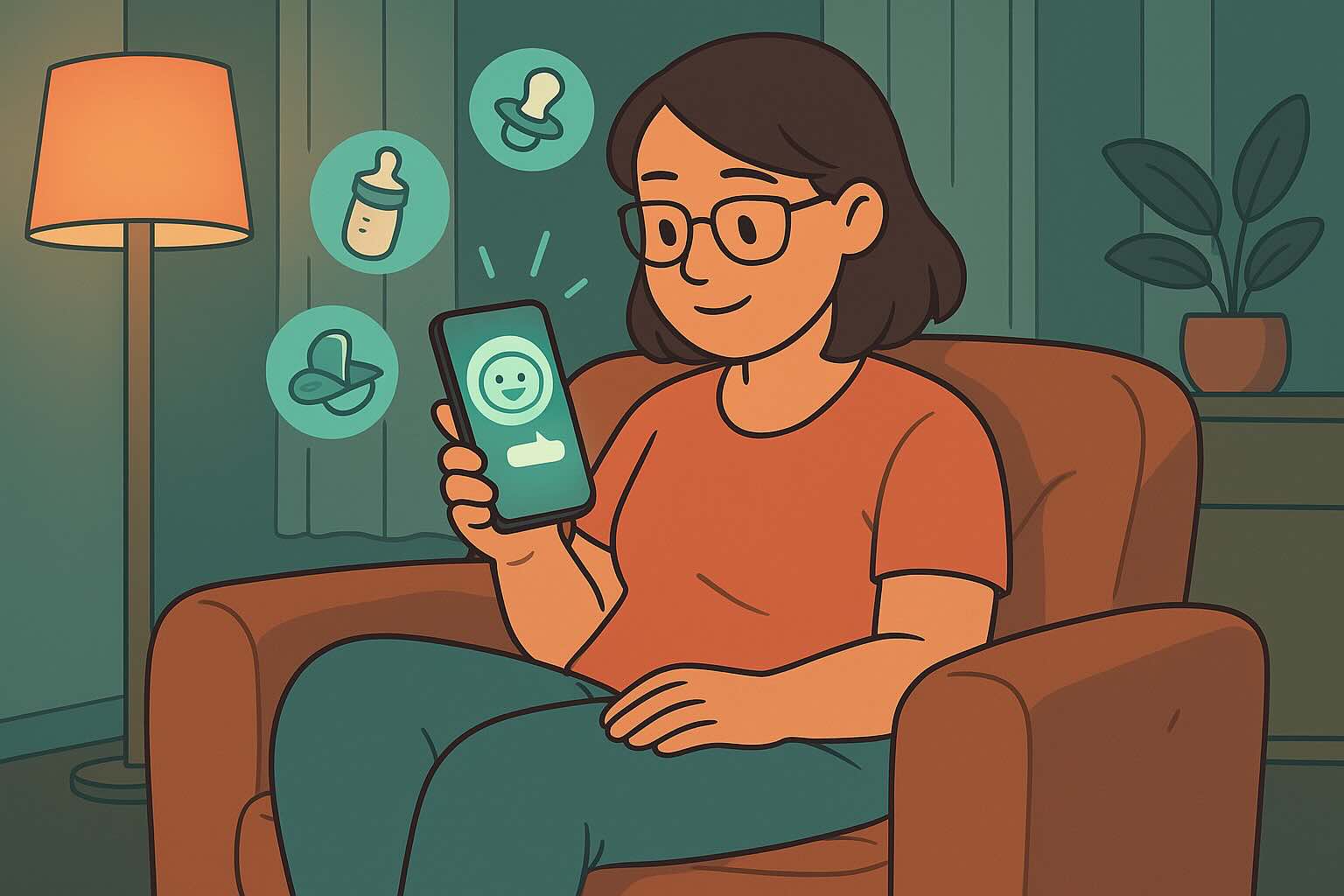
Get Your Free Sleep Training Toolkit
5-day email course + printable sleep log to help your baby sleep through the night
Frequently Asked Questions
Need personalized support?
RootWise's AI coach can provide tailored strategies for your specific situation, available 24/7 when you need it most.
Learn More About AI Coaching →